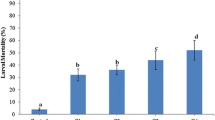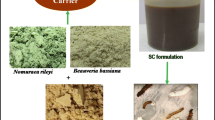Abstract
Bacillus thuringiensis (Bt) toxins present a potential for control of pest mites. Information concerning the effect of Bt and its possible application to the biocontrol of synathropic mites is rare. The toxic effect of Bacillus thuringiensis var. tenebrionis producing Cry3A toxin was tested on the mites Acarus siro L., Tyrophagus putrescentiae (Schrank), Dermatophagoides farinae Hughes, and Lepidoglyphus destructor (Schrank) via feeding tests. Fifty mites were reared on Bt additive diets in concentrations that ranged from 0 to 100 mg g−1 under optimal conditions for their development. After 21 days, the mites were counted and the final populations were analyzed using a polynomial regression model. The Bt diet suppressed population growth of the four mite species. The fitted doses of Bt for 50% suppression of population growth were diets ranging from 25 to 38 mg g−1. There were no remarkable differences among species. Possible applications of Bt for the control of synanthropic mites are discussed.

Similar content being viewed by others
References
Abdel-Razek AS (2002) Comparative study on the effect of two Bacillus thuringiensis strains of the same serotype on three coleopteran pests of stored wheat. J Egypt Soc Parasitol 32:415–424
Athanassiou CG, Kavallieratos NG, Palyvos NE, Sciarretta A, Trematerra P (2005) Spatiotemporal distribution of insects and mites in horizontally stored wheat. J Econ Entomol 98:1058–1069
Beegle CC (1996) Efficacy of Bacillus thuringiensis against lesser grain borer, Rhyzopertha dominica (Coleoptera: Bostrichidae). Biocontr Sci Technol 6:15–21
Carter ME, Villani MG, Allee LL, Losey JE (2004) Absence of non-target effects of two Bacillus thuringiensis coleopteran active delta-endotoxins on the bulb mite, Rhizoglypus robini (Claparede) (Acari, Acaridae). J Appl Entomol 128:56–63
Casique-Arroyo G, Bideshi D, Salcedo-Hernández R, Barboza-Corona JE (2007) Development of a recombinant strain of Bacillus thuringiensis subsp. kurstaki HD-73 that produces the endochitinase ChiA74. Antonie Van Leeuwenhoek 92:1–9
Chapman MH, Hoy MA (1991) Relative toxicity of Bacillus thuringiensis var. tenebrionis to the two-spotted spider mite (Tetranychus urticae Koch) and its predator Metaseiulus occidentalis (Nesbitt) (Acari, Tetranychidae and Phytoseiidae). J Appl Entomol 111:147–154
Collins DA (2006) A review of alternatives to organophosphorus compounds for the control of storage mites. J Stored Prod Res 42:395–426
Cox PD, Wilkin DR (1998) A review of the options for biological control against invertebrate pests of stored grain in the UK. IOBC/WPRS Bull 21:27–32
Dabrowski ZT, Czajkowska B, Bocinska B (2006) First experiments on unintended effects of Bt maize feed on nontarget organisms in Poland. IOBC/WPRS Bull 29:39–42
Erban T, Hubert J (2008) Digestive function of lysozyme in synanthropic acaridid mites enables utilization of bacteria as a food source. Exp Appl Acarol 44:199–212
Fernández-Caldas E, Iraola V, Carnés J (2007) Molecular and biochemical properties of storage mites (except Blomia species). Protein Pept Lett 14:954–959
Fernández-Caldas E, Puerta L, Caraballo L, Lockey RF (2008) Mite allergens. Clin Allergy Immunol 21:161–182
Hassanain MA, el Garhy MF, Abdel-Ghaffar FA, el-Sharaby A, Abdel Megeed KN (1997) Biological control studies of soft and hard ticks in Egypt. I. The effect of Bacillus thuringiensis varieties on soft and hard ticks (ixodidae). Parasitol Res 83:209–213
Hubert J, Stejskal V, Munzbergova Z, Kubatova A, Vanova M, Zdarkova E (2004) Mites and fungi in heavily infested stores in the Czech Republic. J Econ Entomol 97:2144–2153
Hubert J, Stejskal V, Munzbergova Z, Hajslova J, Arthur FH (2007a) Toxicity and efficacy of selected pesticides and new acaricides to stored product mites (Acari: Acaridida). Exp Appl Acarol 42:283–290
Hubert J, Stejskal V, Aspaly G, Munzbergova Z (2007b) Suppressive potential of bean (Phaseolus vulgaris) flour against five species of stored-product mites (Acari: Acarididae). J Econ Entomol 100:586–590
Hughes AM (1976) The mites of stored food and houses, 2nd edn. MAFF Technical Bull 9, London, p 400
Khetan SK (2001) Microbial pest control. Marcel Dekker Inc, NewYork, p 300
Kikuta H, Takagi R (2001) Isolation and acaricidal activity of microorganisms from dead Tyrophagus similis Volgin. J Rakuno Gakuen Univ Nat Sci 25:271–276
Martins ES, Praçaa LB, Dumasa VF, Silva-Wernecka JO, Sonea EH, Wagaa IC, Berryb C, Monnerat RG (2007) Characterization of Bacillus thuringiensis isolates toxic to cotton boll weevil (Anthonomus grandis). Biol Contr 40:65–68
Oliveira AR, Astro TR, Capalo DMF, Delalibera I Jr (2007) Toxicological evaluation of genetically modified cotton (Bollgard®) and Dipel® WP on the non-target soil mite Scheloribates praeincisus (Acari: Oribatida). Exp Appl Acarol 41:191–201
Palyvos NE, Athanassiou CG, Kavallieratos NG (2006) Acaricidal effect of a diatomaceous earth formulation against Tyrophagus putrescentiae (Astigmata: Acaridae) and its predator Cheyletus malaccensis (Prostigmata: Cheyletidae) in four grain commodities. J Econ Entomol 99:229–236
Palyvos NE, Emmanouel NG, Saitanis CJ (2008) Mites associated with stored products in Greece. Exp Appl Acarol 44:213–226
Parkinson CL (1990) Population increase and damage by three species of mites on wheat at 20°C and two humidities. Exp Appl Acarol 8:179–193
Saleh SM, Kelada NL, Shaker N (1991) Control of European house dust mite Dermatophagoides pteronyssinus (Trouessart) with Bacillus spp. Acarologia 32:257–260
Scholler M (1998) Integration of biological and non-biological methods for controlling arthropods infesting stored products. Postharvest News Inf 9:15–20
Sedlacek JD, Komaravalli SR, Hanley AM, Price BD, Davis PM (2001) Life history attributes of Indian meal moth (Lepidoptera: Pyralidae) and Angoumois grain moth (Lepidoptera: Gelechiidae) reared on transgenic corn kernels. J Econ Entomol 94:586–592
Sinha RN, Watters FL (1985) Insect pests of flour mills, grain elevators, and feed mills and their control. Canadian Government Publishing Centre Ottawa, Canada. Agriculture Canada Publication, p 1776
Sobotnik J, Kudlikova-Krizkova I, Vancova M, Munzbergova Z, Hubert J (2008) Chitin in the peritrophic membrane of Acarus siro (Acari: Acaridae) as a target for novel acaricides. J Econ Entomol 101:1028–1033
Stejskal V, Hubert J (2008) Risk of occupational allergy to stored grain arthropods and false pest-risk perception in Czech grain stores. Ann Agric Environ Med 15:29–35
Thind BB, Clarke PG (2001) The occurrence of mites in cereal-based foods destined for human consumption and possible consequences of infestation. Exp Appl Acarol 25:203–215
Tyurin SA, Meshkov YI, Yakovleva IN, Zalunin IA, Hashimov FH, Zhuzhikov DP, Lyutikova LI, Martin PA, Oppert B, Debabov VG (2006) A new insecticidal preparation on the basis of Bacillus thuringiensis with insecto-acaricidal activity. IOBC/WPRS Bull 29:177–182
van Bronswijk JE, Sinha RN (1971) Pyroglyphid mites (Acari) and house dust allergy. J Allergy 47:31–52
van der Geest LPS, Elliot SL, Breeuwer JAJ, Beerling EAM (2000) Diseases of mites. Exp Appl Acarol 24:497–560
Zemek R, Hubert J (2008) Acaricidal activity of Bacillus thuringiensis toxins against mite pests. IOBC/WPRS Bull 31:122
Acknowledgments
The authors thank Terry A. Benson and Dirk A. Ave (Valent Biosciences®) for Novodor FC. We thank Jitka Stara for critical comments, and Sarka Tuckova and Pavel Horak for technical work. We are obligated to anonymous reviewers for the significant improvement of MS. The project was supported as project COST862–OC08065, funded by the Czech Ministry of Education Youth and Sport.
Author information
Authors and Affiliations
Corresponding author
Rights and permissions
About this article
Cite this article
Erban, T., Nesvorna, M., Erbanova, M. et al. Bacillus thuringiensis var. tenebrionis control of synanthropic mites (Acari: Acaridida) under laboratory conditions. Exp Appl Acarol 49, 339–346 (2009). https://doi.org/10.1007/s10493-009-9265-z
Received:
Accepted:
Published:
Issue Date:
DOI: https://doi.org/10.1007/s10493-009-9265-z




